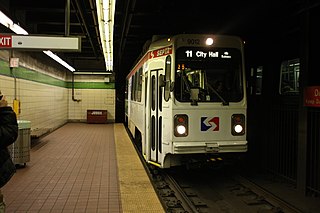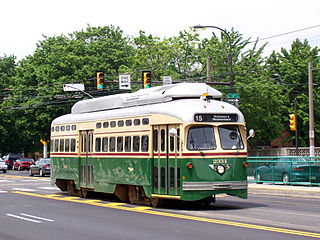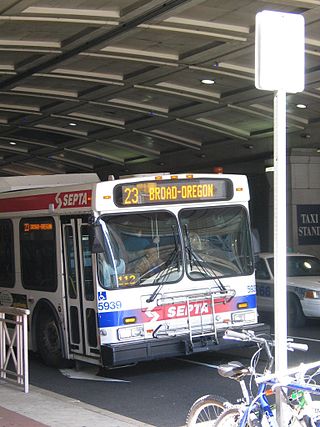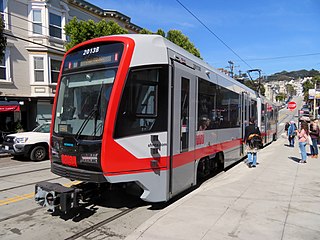Gallery
- A Brilliner in service on the now-defunct Philadelphia Ardmore tram route (Route 103).
- A Brilliner in service with the suburban Philadelphia Red Arrow Lines at 69th Street Terminal.
Brilliner was a tram designed by the J. G. Brill Company. The tram was designed to be a competitor to the successful PCC cars, but the design ended up being a failure for the company, with only several trams built. The tram utilized a clean, streamlined design, similar to a PCC car. It also used a boxy floor plan and a riveted steel body design. Due to the boxy floor plan, Brilliner cars could not clear the tight spaces required by the Philadelphia Transportation Company (PTC), the company's main customer. [1] The Brilliner was the company's last trolley design before merging with American Car and Foundry (ACF).
10 cars were built for Red Arrow Lines (these were the only double ended variants as every other car was single ended), 24 trams were sold to Atlantic City, 3 cars were sold to the PTC, and one of each was sold to Cincinnati and Baltimore. [2] One streetcar, Red Arrow Lines 5, is now on display at the Pennsylvania Trolley Museum. [3]

The Southeastern Pennsylvania Transportation Authority (SEPTA) is a regional public transportation authority that operates bus, rapid transit, commuter rail, light rail, and electric trolleybus services for nearly four million people in five counties in and around Philadelphia, Pennsylvania. It also manages projects that maintain, replace and expand its infrastructure, facilities and vehicles.

The PCC is a tram design that was first built in the United States in the 1930s. The design proved successful domestically, and after World War II it was licensed for use elsewhere in the world where PCC based cars were made. The PCC car has proved to be a long-lasting icon of streetcar design, and many remain in service around the world.

The Philadelphia and Western Railroad was a high-speed, third rail-equipped, commuter-hauling interurban electric railroad operating in the western suburbs of the U.S. city of Philadelphia, Pennsylvania. It is now SEPTA's Norristown High Speed Line, though the Strafford spur has been abandoned. Part of the abandoned line within Radnor Township is now the Radnor Trail, a multi-use path or rail trail.

The F Market & Wharves line is one of several light rail lines in San Francisco, California. Unlike most other lines in the system, the F line runs as a heritage streetcar service, almost exclusively using historic equipment both from San Francisco's retired fleet as well as from cities around the world. While the F line is operated by the San Francisco Municipal Railway (Muni), its operation is supported by Market Street Railway, a nonprofit organization of streetcar enthusiasts which raises funds and helps to restore vintage streetcars.

SEPTA Routes 101 and 102, also known as the Media–Sharon Hill Line, are light rail lines operated by the Suburban Transit Division of the Southeastern Pennsylvania Transportation Authority, serving portions of Delaware County. The routes' eastern terminus is 69th Street Transportation Center in Upper Darby, Pennsylvania. Route 101 runs to Media, while Route 102 goes to Sharon Hill. Altogether, the two lines operate on approximately 11.9 miles (19.2 km) of route. The lines were formerly interurbans.


The SEPTA subway–surface trolley lines are a collection of five SEPTA trolley lines that operate on street-level tracks in West Philadelphia and Delaware County, Pennsylvania, and also underneath Market Street in Philadelphia's Center City. The lines, Routes 10, 11, 13, 34, and 36, collectively operate on about 39.6 miles (63.7 km) of route.

The Brussels tramway network is a tram system serving a large part of the Brussels-Capital Region of Belgium. It is the 16th largest tram system in the world by route length, in 2017 providing 149.1 million journeys over routes 140.6 km (87.4 mi) in length. In 2018, it consisted of 18 tram lines. Brussels trams are operated by STIB/MIVB, the local public transport company.

Route 15, the Girard Avenue Line, is a trolley line operated by the Southeastern Pennsylvania Transportation Authority (SEPTA) along Girard Avenue through North and West Philadelphia, Pennsylvania, United States. As of 2007, it is the only surface trolley line in the City Transit Division that is not part of the Subway–Surface Trolley Lines. SEPTA PCC II vehicles are used on the line.

The McKinney Avenue Transit Authority (MATA), a non-profit organization, operates the M-Line Trolley in Dallas, Texas. In operation since 1989, it is an example of a heritage streetcar running historic cars. The M-Line Trolley operates 7 days per week, 365 days per year. Since 2002, the M-Line Trolley is free to the public, thanks to donations and a joint operating subsidy received from Dallas Area Rapid Transit (DART) and the Uptown Improvement District. The main stretch of the line runs along McKinney Avenue in Uptown between West Village and Klyde Warren Park / Dallas Arts District. The M-Line Trolley connects to the DART light rail system at CityPlace/Uptown on the northern end and St. Paul on the southern end.

The Pennsylvania Trolley Museum is a museum in Washington, Pennsylvania, dedicated to operation and preservation of streetcars and trolleys. The museum primarily contains historic trolleys from Pennsylvania, but their collection includes examples from nearby Toledo, Ohio; New Orleans, and even an open sided car from Brazil. Many have been painstakingly restored to operating condition. Other unique cars either waiting for restoration or incompatible with the Pennsylvania trolley gauge track are on display in a massive trolley display building. Notable examples on static display include a J.G. Brill “brilliner” car which was introduced as a competitor to the PCC, locomotives, and a horse car from the early days of Pittsburgh’s public transit systems.

The Z-class are single-unit bogie trams that operate on the Melbourne tram network. Between 1975 and 1983, 230 trams spanning three sub-classes were built by Comeng, Dandenong. The design was based on two similar Gothenburg tram models, and a prototype built by the Melbourne & Metropolitan Tramways Board. While the Z1 and Z2-class trams were very similar, the Z3-class had significant design changes.

Streetcars or trolley(car)s were once the chief mode of public transit in hundreds of North American cities and towns. Most of the original urban streetcar systems were either dismantled in the mid-20th century or converted to other modes of operation, such as light rail. Today, only Toronto still operates a streetcar network essentially unchanged in layout and mode of operation.

The Philadelphia Transportation Company (PTC) was the main public transit operator in Philadelphia, Pennsylvania, from 1940 to 1968. A private company, PTC was the successor to the Philadelphia Rapid Transit Company (PRT), in operation since 1902, and was the immediate predecessor of the Southeastern Pennsylvania Transportation Authority (SEPTA).

The Southeastern Pennsylvania Transportation Authority operates or contracts operations of these routes serving points in Bucks, Chester, Delaware, and Montgomery counties, with a few routes operating into the city of Philadelphia. The Suburban Transit Division is broken down into three districts: Victory, Frontier, and Contract Operations.

SEPTA Trolley Route 23 is a former streetcar line now operated with buses. It is operated by the Southeastern Pennsylvania Transportation Authority (SEPTA) in Philadelphia, Pennsylvania, United States. The line runs between the Chestnut Hill and Center City neighborhoods via Germantown Avenue, 11th, and 12th Streets.

With five different modes of transport, the San Francisco Municipal Railway runs one of the most diverse fleets of vehicles in the United States. Roughly 550 diesel-electric hybrid buses, 300 electric trolleybuses, 250 modern light rail vehicles, 50 historic streetcars and 40 cable cars see active duty.

The Philadelphia trolleybus system forms part of the public transportation network serving Philadelphia, in the state of Pennsylvania, United States. It opened on October 14, 1923, and is now the second-longest-lived trolleybus system in the world. One of only four such systems currently operating in the U.S., it presently comprises three lines and is operated by the Southeastern Pennsylvania Transportation Authority (SEPTA), with a fleet of 38 trolleybuses, or trackless trolleys as SEPTA calls them. The three surviving routes serve North and Northeast Philadelphia and connect with SEPTA's Market–Frankford rapid transit line.

The PCC II is a series of upgraded PCC streetcars used by the Southeastern Pennsylvania Transportation Authority, in Philadelphia, Pennsylvania, for its Route 15-Girard Avenue.

The San Francisco Historic Trolley Festival was a heritage streetcar service along Market Street in San Francisco, California, United States. It used a variety of vintage streetcars and operated five to seven days a week, primarily in summer months, between 1983 and 1987. Sponsored by the San Francisco Chamber of Commerce and operated by the San Francisco Municipal Railway, it was the predecessor of the F Market & Wharves heritage streetcar line that opened in 1995. It used historic streetcars from several different countries, as well as a number of preserved San Francisco cars. The impetus behind the Trolley Festival was that the city's famed cable car system, one of its biggest tourist attractions, was scheduled to be closed for more than a year and a half for renovation, starting in September 1982. The Trolley Festival was conceived as a temporary substitute tourist attraction during the cable car system's closure.
{{cite web}}: |last= has generic name (help)